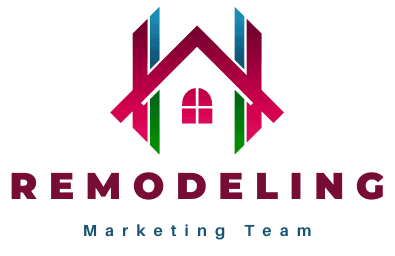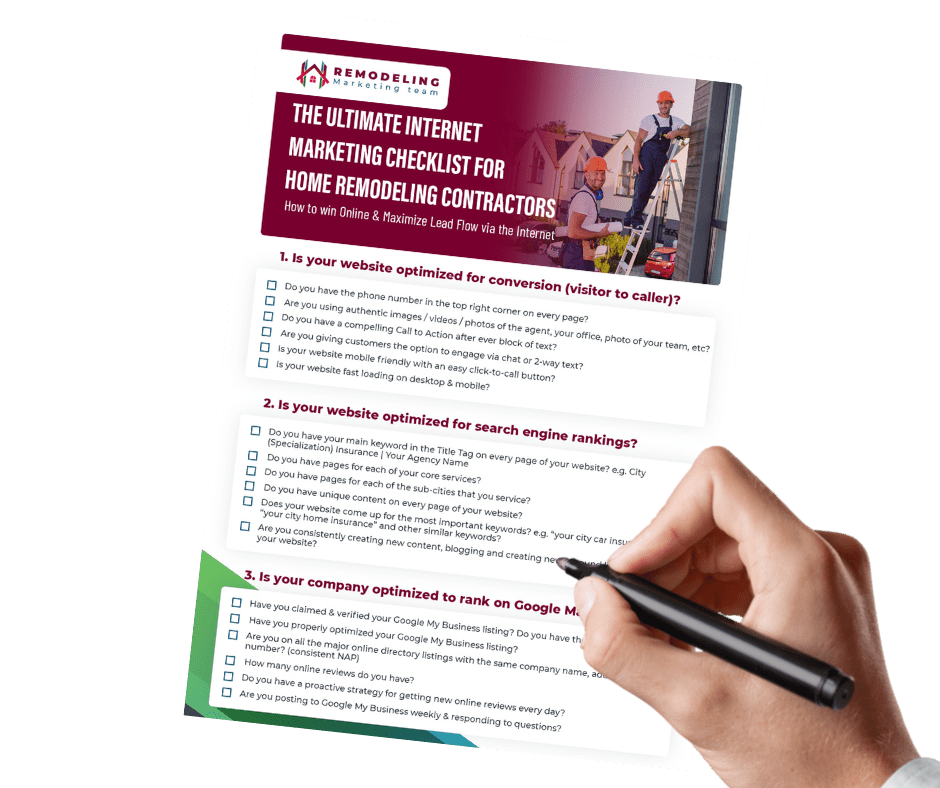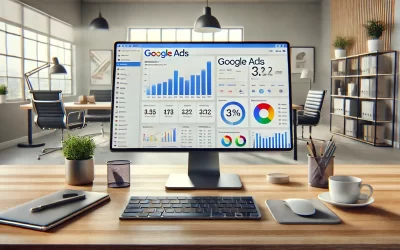Home remodeling is a business shaped by weather, timing, and homeowner psychology. If you’ve been in the industry long enough, you’ve already seen how seasonal cycles impact your leads, labor load, and bottom line.
But here’s the truth: Seasonality shouldn’t dictate your success—it should inform your strategy.
This article lays out a playbook to help remodeling companies of any size market smartly in every season—turning cold months into planning seasons, and peak seasons into profit multipliers. Whether you’re running a lean team or scaling up operations, mastering this approach will drive steady growth, predictable pipelines, and fewer revenue roller coasters.
Key Takeaways
- Seasonality is predictable—use it to your advantage.
Each season brings unique homeowner priorities. Align your messaging, services, and promotions with those seasonal needs to stay relevant and drive consistent leads.
- Spring and summer are for execution; fall and winter are for preparation.
While peak seasons focus on project delivery, off-seasons are your chance to build marketing assets, plan campaigns, and optimize operations for long-term growth.
- Off-season marketing isn’t optional—it’s your growth engine.
Use slower months to create content, nurture your pipeline, generate reviews, and schedule future work. The work you do in winter often determines your spring success.
- Automate and delegate to avoid bottlenecks.
Rely on systems, software, and trusted partners to keep your marketing running while you’re on job sites. Don’t let daily busyness delay strategic growth.
- An annual marketing calendar is your GPS for consistent visibility.
Structure your content, promotions, and outreach around seasonal buying behavior. This keeps your pipeline full and your team engaged year-round.
- Marketing isn’t a task—it’s a system.
Top remodelers don’t just run ads or post blogs; they build repeatable systems that generate leads, earn trust, and support sustainable scaling.
7. Your visibility determines your viability.
If prospects don’t know you, they won’t call you. Invest in being findable, followable, and referable—12 months a year.
Understanding Seasonal Demand Cycles
Success in remodeling comes from knowing your buyer’s mindset—and it shifts with the seasons. Every time the temperature changes or a holiday approaches, your customer’s priorities shift. Understanding these patterns gives you the edge to align your marketing with their motivations, not just your availability.
It’s not just about riding seasonal demand—it’s about shaping it.
Spring: The Launchpad for Remodeling Season
Spring is your ignition switch. After months indoors, homeowners are eager to take action—whether it’s boosting curb appeal, preparing for summer entertaining, or finally tackling the kitchen they’ve been pinning ideas for all winter.
You’re not just selling projects here—you’re selling a fresh start. That emotional trigger is marketing gold.
Popular spring projects:
- Landscaping, garden beds, curb appeal updates
- Exterior painting, siding, and power washing
- Roof inspections and shingle replacements
- Kitchen and bathroom upgrades
- Garage conversions, ADUs, or bonus rooms
Spring marketing strategy tips:
- Launch campaigns in late winter, before competitors flood the space.
- Position your services as solutions to post-winter home headaches.
- Emphasize limited availability to create urgency.
- Use blog content or ads to guide clients from inspiration to action.
Power move: Create a “Spring Project Readiness Checklist” and offer it as a lead magnet on your website.
Summer: Peak Project Season
Summer is the money-making season—but also the biggest trap. If you only focus on fulfilling work, you risk leaving your marketing on autopilot and stalling your momentum.
This is the season to maximize referrals, document wins, and line up future projects.
Common summer services:
- Outdoor kitchens, decks, and patios
- Major kitchen remodels and open floorplans
- Energy-efficient window and door installations
- HVAC and ventilation improvements
- Poolside structures, fencing, and sunrooms
Summer marketing strategy tips:
- Promote packages for outdoor living or entertaining upgrades.
- Capture and share content from active jobs (before/after, drone shots, video walkthroughs).
- Use SMS/email to keep clients informed and excited during multi-week jobs.
- Ask for reviews before the project ends—when satisfaction is highest.
Power move: Run a summer contest—ask clients to post photos of their new space for a chance to win a small giveaway. Creates content and social proof.
Fall: The Season of Practical Planning
Fall is when responsible homeowners get serious. It’s not flashy, but it’s one of the most strategic marketing windows of the year.
Your messaging here should speak to prevention, efficiency, and peace of mind—people want to avoid cold-weather disasters, not deal with them mid-January.
Popular fall projects:
- Insulation, weatherproofing, and energy upgrades
- Gutter maintenance and drainage solutions
- Heating system installs or repairs
- Door/window replacements for energy efficiency
- Smart thermostat or system automation upgrades
Fall marketing strategy tips:
- Use “before winter hits” as a psychological trigger.
- Launch a “Fall Fix-Up” package: one service + one inspection.
- Focus content on ROI and energy savings—not just aesthetic.
- Educate your audience on local rebates or energy credits.
Power move: Create a 5-point Winter Readiness Inspection and offer it free with any service booked before November.
Winter: Build for the Season Ahead
Winter doesn’t need to be your slow season—it needs to be your strategic season. This is when the best remodelers regroup, reassess, and rebuild their client pipeline for spring.
It’s also the ideal time to connect with homeowners who are still researching and budgeting for future projects.
In-demand winter services:
- Basement finishing, game rooms, and media centers
- Interior painting and flooring
- Home office or guest room conversions
- Open concept redesigns and layout planning
- Consultations for large spring renovations
Winter marketing strategy tips:
- Offer free design consults for early 2025 projects.
- Promote tax-season upgrades (especially if customers receive refunds).
- Share behind-the-scenes videos: staff training, tool restocking, “next-level prep.”
- Invest in retargeting ads to stay visible while clients are in research mode.
Power move: Create an “Early Bird Spring Project” VIP list with incentives for booking ahead—then promote it via email and social media ads.
Off-Season Marketing Strategies That Build Long-Term Growth
If you’re not generating leads during your off-season, you’re not running a business—you’re waiting for one.
The slower months are your chance to create leverage. It’s when you can produce assets that work for you when you’re back in the field. Off-season marketing isn’t optional—it’s your multiplier effect.
Key Areas to Focus:
- Blog & SEO Content: Answer your client’s questions before they ever call you. Build trust through education.
- Email Nurture Sequences: Set up campaigns that move leads from cold to ready.
- Video Testimonials: Schedule shoots with past clients. A good video sells better than any ad.
- Social Proof: Show consistent evidence that you’re active, reliable, and booked out—scarcity builds demand.
Power move: Use your CRM to re-engage stale leads who didn’t move forward last year. A personal touchpoint could re-ignite interest.
Creating an Annual Marketing Calendar
Consistency beats intensity. A well-built marketing calendar gives you structure, saves time, and prevents feast-or-famine marketing.
Think of it as your business’s marketing GPS—it keeps you on the right path, even when you’re buried in job sites or client meetings.
What to Include:
- Monthly blog and newsletter topics
- Social media themes (e.g., Transformation Tuesdays)
- Seasonal ad campaign launches
- Quarterly promotions
- Client appreciation events or referral pushes
Power move: Schedule 80% of your content in one-week quarterly sprints—then spend your time engaging, not scrambling.
Automate and Delegate to Scale
You can’t scale what you’re still doing manually. If you’re the craftsman, crew manager, AND marketer—you’ll always hit a ceiling.
Smart businesses automate their visibility and delegate their complexity.
What to Automate:
- Social media scheduling
- Email drip campaigns
- Lead capture forms and follow-ups
- Google Review requests
What to Delegate:
- Content writing and video editing
- Ad campaign setup and tracking
- SEO and website updates
Power move: Consider hiring a fractional CMO or contractor marketing agency that speaks your language and understands how to generate qualified leads—not just clicks.
Final Thoughts: Own the Calendar, Own the Revenue
There’s no off-season when your marketing engine runs year-round. If you want predictable leads, higher quality clients, and a business that grows even while you’re on a jobsite, it starts with a seasonal strategy anchored in consistency.
Don’t let the calendar control your business. Build a calendar that controls your growth.
Ready to Craft a 12-Month Marketing Plan That Works?
Let’s talk.Schedule a free strategy session and walk away with real clarity on how to dominate your market—season after season.
Frequently Asked Questions (FAQs)
Why is seasonal marketing important for remodeling businesses?
Remodeling demand naturally fluctuates with the seasons—spring and summer are typically busy, while fall and winter slow down. Strategic seasonal marketing ensures you’re consistently visible, attracting leads year-round, and avoiding revenue dips in the off-season.
What kind of marketing should I focus on during the slower winter months?
Winter is ideal for planning, creating content, reconnecting with past leads, and booking early spring projects. Focus on email marketing, blog content, video testimonials, retargeting ads, and offering consultations to keep your pipeline warm.
How far in advance should I plan my seasonal marketing?
Ideally, plan your entire year in one sitting, then break it down quarterly. Use your slower months (fall and winter) to build and schedule content, campaigns, and promotions in advance—so you’re not scrambling during the busy season.
What’s the best way to automate my seasonal marketing?
Use tools like:
- Also, consider outsourcing content creation or ad management to free up your time.
- Buffer or Later for social media scheduling
- Mailchimp or ActiveCampaign for email automation
- Zapier to connect lead forms with your CRM and nurture sequences
- Google My Business tools to auto-post updates and promotions
How do I know which seasonal projects to promote?
Track demand trends from past years, listen to what clients are asking for, and stay in tune with seasonal homeowner concerns (e.g., energy bills in fall, home offices in winter, outdoor entertaining in summer). Promote the services that align with those seasonal needs.
What should be included in my annual marketing calendar?
Include:
- Staff marketing responsibilities (content, photos, reviews)
- Monthly blog or social topics
- Email newsletter and automation plans
- Seasonal promotions
- Key local events or home shows
- Project milestones or deadlines
- Ad campaign schedules
What if I don’t have time to do all of this?
That’s where delegation comes in. You don’t need to do everything yourself. Hire a virtual assistant, freelance marketer, or fractional CMO to execute tasks. Focus on what only you can do—vision, leadership, and high-level client interactions.
How can I use my current jobs to help with marketing?
Active jobs are goldmines for marketing. Take progress photos, interview satisfied clients, and post behind-the-scenes content. Turn real work into social proof that drives trust and leads.
Can seasonal marketing really help me grow my business year-round?
Absolutely. Remodelers who market year-round build stronger pipelines, avoid slow months, and gain market share while competitors go quiet. It’s not just about growth—it’s about stability, scalability, and reputation-building.






